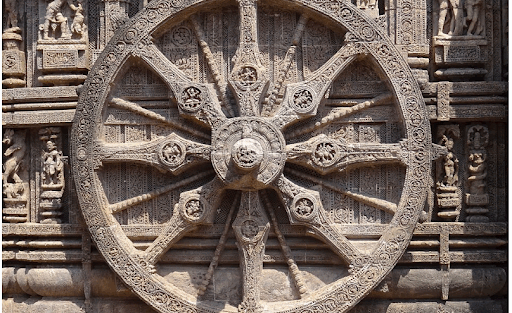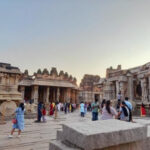The Eastern Ganga Dynasty: The Forgotten Dynasty

The Eastern Ganga Dynasty: The Forgotten Dynasty
The Chariot Wheel of Sun Temple, Konark, Odisha 2011. Photograph. wikimedia. Source: https://en.wikipedia.org/wiki/File:Konark_Sun_Temple_Wheel.jpg. Date of Accession:(14th March 2025).
The landmass of India, as we know it today, was once divided among several kingdoms ruled by various dynasties. Among them was the Eastern Ganga Dynasty, which ruled over the eastern part of India, primarily in Odisha. This blog delves into the history of this dynasty, renowned for their magnificent temple architecture that serves as a testament to their power and piety, the period of their greatest prosperity, and the factors that eventually led to their decline.
Brief History: Rise to Power

Map of the Eastern Gangas. 2022. map of India. Wikimedia. Source: https://commons.wikimedia.org/wiki/File:Map_of_the_Eastern_Gangas.png. Date of Accession:(14th March 2025).
The Eastern Ganga Dynasty, also known as the Rudhi Gangas or Prachya Gangas, ruled from the 5th to the 15th century AD. The dynasty is said to have been founded by Anantavarman Chodaganga Deva in the Kalinga region (modern-day Odisha and parts of Andhra Pradesh). The origins are shrouded in some mystery, with different theories linking them either to the indigenous origins of Kalinga or to a branch of the Western Ganga Dynasty of Karnataka. Regardless of their exact ancestry, by the 5th century, they had established themselves as a formidable force, gradually expanding their influence and consolidating their power.The early Gangas ruled from Kalinganagara (present-day Mukhalingam in Andhra Pradesh), primarily as feudatories before establishing their independent reign. Anantavarman’s conquests extended their dominion significantly, encompassing a large swathe of eastern India, from the Hooghly River in Bengal to the Godavari River in Andhra Pradesh. His long and prosperous reign laid the foundation for the dynasty’s golden age.
The Flourishing Period

Bhimbetka Rock shelters
Broken stone panel from Konark ruins depicting Narasingha Deva I practicing archery. 2023. Photograph. Konark Sun temple, Odisha. Source: https://theindosphere.com/history/king-narasimhadeva-i/. Date of Accession:(14th March 2025).
The period from the late 12th to the mid-13th century, encompassing the reigns of Anangabhima III and Narasimhadeva I, is generally considered the flourishing period of the Eastern Ganga Dynasty. This era witnessed Military Supremacy: The Ganga army consistently repelled invasions from neighboring kingdoms and sultanates, maintaining the territorial integrity of their empire. Their victories boosted their prestige and solidified their control over the region. Economic Prosperity: Agriculture flourished, supported by a well-organized irrigation system. Trade and commerce thrived, both internally and with overseas partners, contributing to the kingdom’s wealth. This prosperity allowed the rulers to invest in grand building projects and support artistic endeavors.
Temple Architecture: A Testament to Ganga Glory

Konarka Temple. 2020. Photograph. Konark Sun temple, Odisha. Source: https://commons.wikimedia.org/wiki/File:Konarka_Temple.jpg. Date of Accession:(14th March 2025).
The Eastern Ganga Dynasty left an indelible mark on Indian temple architecture, developing a distinct Kalinga style within the broader Nagara school. Their temples, known for their elegant curvilinear towers (shikharas), intricate carvings, and harmonious proportions, stand as testaments to their artistic and religious devotion.Some of the famous temples built by them are:
Jagannath Temple, Puri: Commissioned by Anantavarman Chodaganga Deva, this temple is a major Hindu pilgrimage site, famous for the Rath Yatra festival.
Sun Temple, Konark: Built by Narasimhadeva I, this UNESCO World Heritage Site is designed as a colossal chariot of the Sun God, adorned with intricate carvings.

Lingaraja temple. 2024. Photograph. Lingaraja temple, Bhubaneshwar, Odisha. Source: https://famoustemplesofindia.com/lingaraj-temple-odishas-architectural-marvel/. Date of Accession:(14th March 2025).
Lingaraj Temple, Bhubaneswar: Though its origins predate the Gangas, they played a key role in shaping its grand and evolved architectural style.
Mukhalingam Temples, Andhra Pradesh: These early Eastern Ganga structures provide valuable insights into the evolution of their architectural style.
The temples of the Eastern Gangas remain a cornerstone of Odisha’s cultural and spiritual heritage, drawing historians, pilgrims, and art lovers alike.
Decline: How the Dynasty Saw Its End
The beginning of the end of the Eastern Ganga Dynasty is both an interesting and saddening chapter in history. The dynasty’s power began to decline after the death of King Narasimhadeva I in 1264. The dynasty then faced several challenges, including invasions from the Delhi Sultanate in 1324.
The first blow was faced during the reign of King Bhanudeva IV, the last ruler of the dynasty. During his rule, internal conflicts and weakening of central authority began. The internal rivalries weakened the dynasty from within. The lack of a strong central authority led to instability and fragmentation. His minister, Kapilendra Deva, seized power, founding the Suryavamsa Gajapati Dynasty. By the 15th century, the Gajapatis had effectively conquered the Ganga kingdom, marking the end of their long and influential rule.
Conclusion
Despite their eventual decline, the Eastern Ganga Dynasty left an indelible mark on the history and culture of eastern India. Their patronage of art, religion, and architecture resulted in a rich cultural heritage that continues to inspire and awe. Their decline serves as a reminder that even the most powerful dynasties can fall, but their legacies endure through the monuments and traditions they leave behind.
Bibliography:
⦁Ancient India. R.C. Majumdar, motilal Banarsidass publications, 1995
⦁Sircar, Dineschandra. Indian Epigraphy. Motilal Banarsidass, 1996.
⦁Mirashi, Vasudev Vishnu. Literary and Historical Studies in Indology. Motilal Banarsidass, 1975.
⦁”Eastern Ganga Dynasty.” Wikipedia, last modified March 14, 2025.
About the Author:
Author: Jyotirmoy Dutta
Jyotirmoy Dutta is a 19-year-old student at Thadomal Shahani Engineering College under Mumbai University, pursuing a degree in Artificial Intelligence and Data Science. Passionate about history, architecture, and archaeology, he is also passionate about researching the intricate details of ancient and medieval Indian temples. His deep fascination with sculptural art extends beyond research, as he actively engages in creating sculptures, blending tradition with artistic expression.




